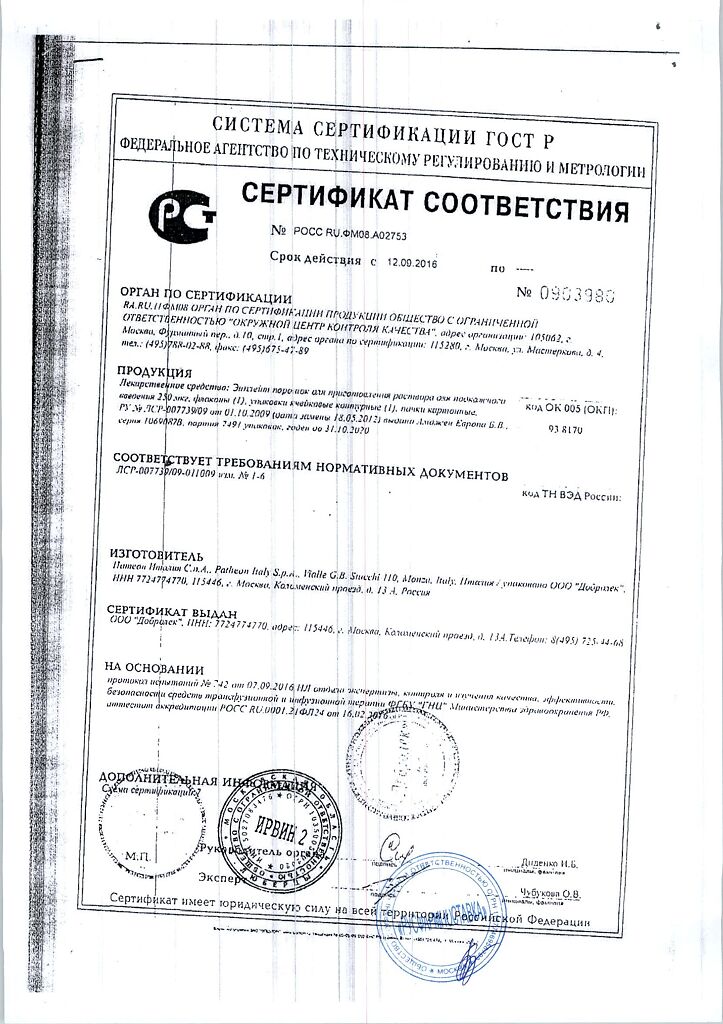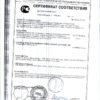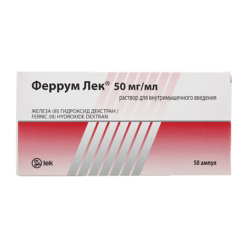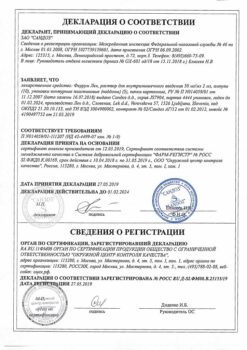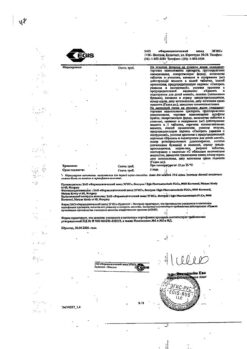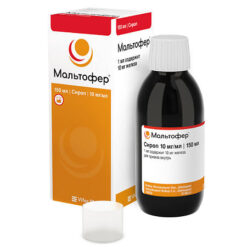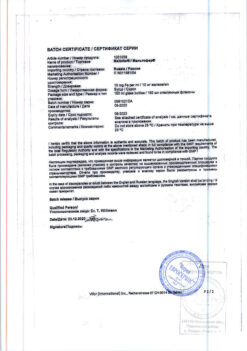No products in the cart.
Enplate 250 mcg
€1.00
Out of stock
(E-mail when Stock is available)
Description
Pharmacological action – stimulating thrombopoiesis.
Pharmacodynamics
Romiplostim is an Fc-peptidylated protein (peptide antibody) involved in signaling and activation of intracellular transcription through binding to thrombopoietin (TPO) receptors (also known as cMpl) and inducing increased platelet formation. The peptide antibody molecule consists of an Fc-fragment of human immunoglobulin IgG1, in which each single-chain subunit is covalently linked at the C-end to a peptide chain containing two TPO receptor-binding fragments.
The amino acid sequence of romiplostim is not homologous to the amino acid sequence of endogenous TPO. No cross-reactivity of antibodies to Romiplostim with endogenous TPO was observed in preclinical and clinical studies.
Clinical efficacy
The efficacy and safety of Romiplostim has been evaluated with a treatment duration of up to 3 years. In clinical trials, treatment with Romiplostim resulted in a dose-dependent increase in platelet count. The time to maximum effect on platelet counts was about 10-14 days and was independent of the dose. After a single p/c administration of romiplostim at a dose of 1 to 10 mcg/kg in patients with idiopathic (immune) thrombocytopenic purpura (ITP), the peak platelet count was 1.3-14.9 times the baseline platelet count within 2-3 weeks. The response to treatment varied in all patients. The majority of patients with ITP who received romiplostim at doses ranging from 1 to 3 mcg/kg for 6 weeks had platelet counts ranging from 50 to 450 × 109/L. Of the 271 patients with ITP who received romiplostim in clinical trials, 55 (20%) were 65 years of age or older, and 27 (10%) were 75 years of age or older. In placebo-controlled trials, no differences in safety and efficacy were found between older and younger patients.
Results from basic placebo-controlled studies
The safety and efficacy of romiplostim was evaluated in two placebo-controlled, double-blind studies in adult patients with ITP who received at least one course of treatment before participating in the study and who represented the full spectrum of the ITP patient population. Both studies followed a similar design. Patients (over 18 years of age) were randomized in a 2:1 ratio and received a starting dose of romiplostim of 1 mcg/kg or placebo, respectively. Patients received a single weekly injection for 24 weeks. Doses were adjusted to maintain platelet counts (50 to 200 × 109/L). In both studies, efficacy was determined by an increase in the number of patients in whom a sustained increase in platelet count was achieved. The average weekly dose in patients with splenectomy was 3 mcg/kg, and 2 mcg/kg in patients with preserved spleen.
In both studies, a significantly higher proportion of patients who received romiplostim showed a sustained response in the form of increased platelet counts compared to patients who received placebo. In placebo-controlled studies after the first 4 weeks of romiplostim, platelet counts were maintained at ≥50 × 109/L in 50-70% of patients during the 6-month treatment period. In the placebo group, only 0-7% of patients showed an increase in platelet count during the 6-month treatment period. In both studies, patients already receiving therapy for ITP according to the established regimen continued to use these drugs for the entire study period (corticosteroids, danazol and/or azathioprine). At the beginning of the study 21 patients with preserved spleen and 18 patients who underwent splenectomy received therapy with drugs for ITP (predominantly corticosteroids). In all patients (100%) after splenectomy who received romiplostim it was possible to reduce the dose of corticosteroids by more than 25%, or even to cancel standard therapy for ITP at the end of treatment, compared with 17% of patients who received placebo. In 73% of patients with preserved spleen who received romiplostim, it was possible to reduce the dose by more than 25%, or even to cancel standard therapy for ITP at the end of treatment, compared with 50% of patients who received placebo.
Bleeding Events
An inverse relationship between bleeding events and platelet counts was observed throughout the clinical ITP treatment program. All clinically significant bleeding events (≥3 grade) occurred at platelet counts < 30 × 109/L. All cases of bleeding ≥ grade 2 occurred at platelet counts < 50 × 109/L. There were no statistically significant differences between all observed bleeding events among patients receiving Enplat or placebo. In two placebo-controlled studies, 9 patients experienced bleeding that was considered serious, (5 [6%] romiplostim, 4 [9.8%] placebo; relative risk [romiplostim/placebo] = 0.59; 95% confidence interval = (0.15; 2.31)). Bleeding events of grade 2 or higher occurred in 15% of patients receiving romiplostim and 34% of patients receiving placebo (relative risk; [romiplostim/placebo]=0.35; 95% confidence interval = (0.14; 0.85)).
Pharmacokinetics
The pharmacokinetics of romiplostim are based on the target-mediated distribution of the drug, which is probably due to receptors for thrombopoietin (TPO) located on the surface of platelets and other platelet-derived cells, such as megakaryocytes.
Absorption
After p/c administration of 3 to 15 µg/kg romiplostim, Cmax in plasma in patients with idiopathic (immune) thrombocytopenic purpura (ITP) was noted after 7-50 h (mean, 14 h). Plasma drug concentrations varied among patients and did not correlate with the administered dose. Plasma concentrations of Romiplostim are probably inversely related to platelet counts.
Distribution
The distribution volume of romiplostim in healthy volunteers after IV administration decreased nonlinearly from 122; 78.8 to 48.2 mL/kg for IV doses of 0.3; 1.0 and 10 µg/kg, respectively. This nonlinear decrease in volume of distribution is consistent with the target-mediated binding of romiplostim (megakaryocyte and platelet receptors), which can be saturated at higher doses.
The T1/2 of Romiplostim in patients with ITP varies from 1 to 34 days (average, 3.5 days). The plasma excretion of Romiplostim depends in part on the expression of TPO receptors on platelets. As a consequence of the dose received, patients with high platelet counts show low plasma concentrations and vice versa. In another study involving patients with ITP, no cumulation was observed after 6 weeks of weekly use of romiplostim (3 mcg/kg).
Particular patient groups
There have been no studies of the pharmacokinetics of Romiplostim in patients with renal and hepatic impairment. Presumably, the pharmacokinetics of Romiplostim are not affected by age, body weight and sex to a clinically significant degree.
Indications
Indications
Active ingredient
Active ingredient
Composition
Composition
The drug Enplate contains:
Each vial of Enplate, 250 mcg, powder for preparation of a solution for subcutaneous injection, contains 375 mcg of Romiplostim. An excess of the contents of each vial ensures the administration of 250 µg of Romiplostim. The 0.5 ml of the resulting solution will contain 250 µg of Romiplostim (the drug concentration will be 500 µg/ml).
How to take, the dosage
How to take, the dosage
Always use the drug in full accordance with your physician’s recommendations.
Check with your doctor if you have any doubts.
Application in adults and children (ages 1 to 17 years)
Recommended dosage
The starting dose is 1 microgram of Enplet per kilogram of body weight (once a week). Your physician will tell you how much Enplatelet you should receive. In order to increase your platelet count, injections of Enplatelet should be given once a week. Your physician will take regular blood samples to assess the platelet response. The dose will be adjusted if necessary.
When your platelet count is under control, your physician will continue to check your blood regularly. The dose may be adjusted to maintain the correct platelet count over time.
Application in children (ages 1 to 17 years)
In addition to determining your platelet count, your doctor will also measure your body weight regularly to adjust the dose.
The route and/or route of administration
Enplet is used under the direct supervision of your doctor, who will carefully monitor the dose you are getting.
Enplet is given once a week as a subcutaneous injection.
If you have used more Enplate than you should
The doctor who treats you will make sure you are getting the correct dose of Enplate. You may not experience any physical symptoms if you use a higher dose of Enplate, but your platelet count may become very high, increasing your risk of blood clots. Therefore, if your doctor suspects that a higher dose of Enplate is being used, it is recommended that you watch for any signs or symptoms of adverse reactions and get appropriate treatment immediately.
If you have used less Enplate than you should
The attending physician will make sure you are getting the correct dose of Enplate. You may not experience any physical symptoms if you use a lower dose of Enplate, but your platelet count may decrease, resulting in an increased risk of bleeding. Therefore, if your physician suspects you are using a lower dose of Enplate, it is recommended that you watch for any signs and symptoms of adverse reactions and get appropriate treatment immediately.
If you forget to use Enplate
If you miss a dose of Enplate, your healthcare provider will arrange with you when the next dose should be given.
If you stop using Enplate
If you stop using Enplate, you may experience a recurrence of thrombocytopenia (decreased platelet count). Your doctor will decide if you can stop using Enplatelet.
Contact your doctor if you have any questions about the use of the drug.
Interaction
Interaction
Special Instructions
Special Instructions
Consult with your doctor, pharmacist, or nurse before using Enplatelet:
The following factors also increase your risk of blood clots:
Synopsis
Synopsis
Contraindications
Contraindications
Side effects
Side effects
Like all medicines, this medicine can cause adverse reactions, but not everyone has them.
The most serious adverse reactions that can occur with Enplate are listed below:
Frequent – may occur in no more than 1 in 10 people (may be detected by blood and urine tests):
Pregnancy use
Pregnancy use
Additional information
| Shelf life | 3 years |
|---|---|
| Conditions of storage | Store the product out of the reach of children where they cannot see it. Do not use after the expiration date printed on the carton and vial label after "Expired until:". The expiration date is the last day of that month. Store between 2 and 8°C. Do not freeze. Store in the original package (carton) to protect it from light. The product can be stored outside the refrigerator for 30 days at a temperature not exceeding 25 °C in the original package (carton pack). After dilution: for 24 hours at 25 °C or for 24 hours at 2 to 8 °C in the original package (carton pack) to protect from light. Do not dispose of any medicines in the sewer system or with household waste. Ask your pharmacy technician how to dispose of medicines that Do not throw them away. |
| Manufacturer | Pateon Inc, Canada |
| Medication form | solution for injection |
| Brand | Pateon Inc |
Related products
Buy Enplate 250 mcg with delivery to USA, UK, Europe and over 120 other countries.


